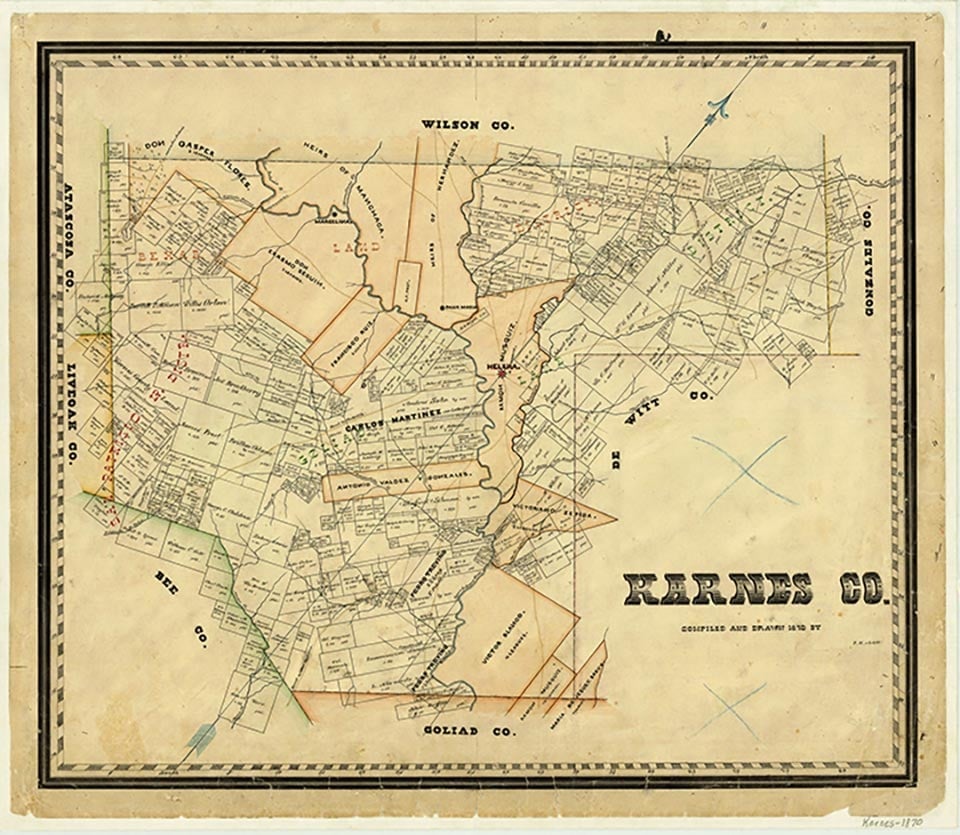Falls City
Falls City, a mile southeast of the Wilson county line and seven miles northwest of Karnes City in northern Karnes County, owes its development to the railroad. Two earlier communities, Marcelina and Home Valley, had been located in the vicinity in the 1850s and 1860s, but people were not induced to settle the area until 1886, when the San Antonio and Aransas Pass Railway built a switch and depot called Brackenridge, named after railroad benefactor George W. Brackenridge. To provide postal service for the settlement that developed, the post office of Skiles was established a mile west of the depot in 1887. On November 28, 1893, it was moved closer to the tracks on the east side of the river, where it was consolidated with Brackenridge and renamed Falls City, after several nearby natural waterfalls. On June 25, 1893, a train robbery at Brackenridge resulted in the only hanging at Karnes City, the new county seat. In 1895 Falls City had one general store, a post office, two saloons, a lumberyard, a hotel, a depot, two livery stables, and a steam mill and gin. The principal place of business was the Schulz Mercantile Company, which operated in a large brick building until it burned down in 1935. The site was later occupied by the Falls City National Bank.
A number of people from Panna Maria and Cestohowa moved to Falls City, where they could receive the benefits of a railroad. As a result Falls City became a predominantly Polish-American settlement. In 1902 Holy Trinity Catholic Church was erected; a parish school opened in 1911. In 1924 the Columbian Hall was built for the Knights of Columbus; it was replaced by the Falls City Community Hall in 1983. In 1931 a new Catholic school, built for $4,000, enrolled 100 students. In 1938 a public school was built, and a high school was added in 1950. Polish-American farmers east and west of the town did most of their trading at Falls City, which incorporated on September 28, 1946. The discovery of oil helped the town to grow. After the discovery of uranium in 1958 near Tordilla Hill, ten miles west of Falls City, uranium mining and milling developed. In the mid-1970s the town was seriously divided over the uranium mines, which were said to contaminate the land and water. Businessmen wanted the mines to continue operation, but farmers did not. The conflict continued in the 1990s. By 1993 the uranium activity, except for a multimillion-dollar reclamation project by federal authorities, was all but over. In 1993 Falls City had a mayor-council form of government and a population of 478. In 2000 the population was 591.
Robert H. Thonhoff | © TSHA

Adapted from the official Handbook of Texas, a state encyclopedia developed by Texas State Historical Association (TSHA). It is an authoritative source of trusted historical records.

- ✅ Adoption Status:
- This place is available for adoption! Available for adoption!
- Adopted by:
- Your name goes here
- Dedication Message:
- Your message goes here
Belongs to
Falls City is part of or belongs to the following places:
Currently Exists
Yes
Place type
Falls City is classified as a Town
Associated Names
- (Brackenbridge)
- (Home Valley)
- (Marcelena)
- (Skiles)
Location
Latitude: 28.98211630Longitude: -98.02163600
Has Post Office
Yes
Is Incorporated
Yes
Population Count, 2021 View more »
544

